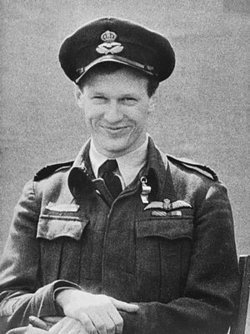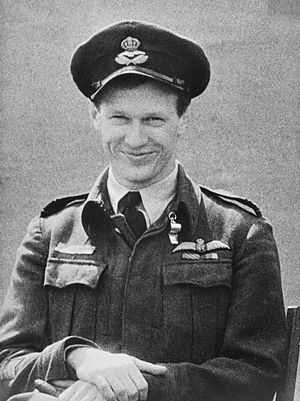Born in Calgary, Alberta, Canada, his family moved to Toronto, Ontario, Canada in 1923 where he received his primary education. In 1927 he moved with his family to New Malden, England where he was further educated at Rokeby Preparatory School in Wimbledon, London, England and the Beverley Boy Secondary School, as well as a private tutor. At age 13, he contracted tuberculosis and was hospitalized for five months.
After World War II broke out in September 1939, he entered the British Army Royal Artillery and was commissioned a 2nd lieutenant serving as an instructor in the Searchlight Section. In 1941 he transferred to the RAF Volunteer Reserve and took flight training and received his wings. The following year he was promoted to the rank of pilot officer and joined the No. 115 Royal Air Force Squadron at Mildenhall, Suffolk, England, where he flew Vickers Wellington bomber aircraft for mine-laying sorties in the North Sea.
In March 1943 his unit transitioned to Avro Lancaster bomber aircraft and flew combat missions over France and Germany and was awarded the Distinguished Flying Cross the following May. After completing his required 28 combat tours, he became an instructor and flight commander at Lossiemouth, Scotland and the following year, he volunteered for the Pathfinder Force, joining the No. 635 Squadron RAF No. 8 in April 1944.
He continued to fly combat missions in Europe and his 58th and final mission was to bomb the German V-1 rocket storage caves at Trossy St. Maximin, France on August 4, 1944 when he was killed at the age of 25 when he unsuccessfully attempted to crash-land his crippled aircraft after completing the mission. His Victoria Cross citation reads: " On 4th August, 1944, Squadron Leader Bazalgette was "master bomber" of a Pathfinder squadron detailed to mark an important target at Trossy St. Maximin for the main bomber force. When nearing the target his Lancaster came under heavy anti-aircraft fire. Both starboard engines were put out of action and serious fires broke out in the fuselage and the starboard main-plane. The bomb aimer was badly wounded. As the deputy "master bomber" had already been shot down, the success of the attack depended on Squadron Leader Bazalgette and this he knew. Despite the appalling conditions in his burning aircraft, he pressed on gallantly to the target, marking and bombing it accurately. That the attack was successful was due to his magnificent effort. After the bombs had been dropped the Lancaster dived, practically out of control. By expert airmanship and great exertion Squadron Leader Bazalgette regained control. But the port inner engine then failed and the whole of the starboard main-plane became a mass of flames. Squadron Leader Bazalgette fought bravely to bring his aircraft and crew to safety. The mid-upper gunner was overcome by fumes. Squadron Leader Bazalgette then ordered those of his crew who were able to leave by parachute to do so. He remained at the controls and attempted the almost hopeless task of landing the crippled and blazing aircraft in a last effort to save the wounded bomb aimer and helpless air gunner. With superb skill, and taking great care to avoid a small French village nearby, he brought the aircraft down safely. Unfortunately, it then exploded and this gallant officer and his two comrades perished. His heroic sacrifice marked the-climax of a long career of operations against the enemy. He always chose the more dangerous and exacting roles. His courage and devotion to duty were beyond praise."
His Victoria Cross is on display at the Royal Air Force Museum in Hendon, Greater London, England.
Born in Calgary, Alberta, Canada, his family moved to Toronto, Ontario, Canada in 1923 where he received his primary education. In 1927 he moved with his family to New Malden, England where he was further educated at Rokeby Preparatory School in Wimbledon, London, England and the Beverley Boy Secondary School, as well as a private tutor. At age 13, he contracted tuberculosis and was hospitalized for five months.
After World War II broke out in September 1939, he entered the British Army Royal Artillery and was commissioned a 2nd lieutenant serving as an instructor in the Searchlight Section. In 1941 he transferred to the RAF Volunteer Reserve and took flight training and received his wings. The following year he was promoted to the rank of pilot officer and joined the No. 115 Royal Air Force Squadron at Mildenhall, Suffolk, England, where he flew Vickers Wellington bomber aircraft for mine-laying sorties in the North Sea.
In March 1943 his unit transitioned to Avro Lancaster bomber aircraft and flew combat missions over France and Germany and was awarded the Distinguished Flying Cross the following May. After completing his required 28 combat tours, he became an instructor and flight commander at Lossiemouth, Scotland and the following year, he volunteered for the Pathfinder Force, joining the No. 635 Squadron RAF No. 8 in April 1944.
He continued to fly combat missions in Europe and his 58th and final mission was to bomb the German V-1 rocket storage caves at Trossy St. Maximin, France on August 4, 1944 when he was killed at the age of 25 when he unsuccessfully attempted to crash-land his crippled aircraft after completing the mission. His Victoria Cross citation reads: " On 4th August, 1944, Squadron Leader Bazalgette was "master bomber" of a Pathfinder squadron detailed to mark an important target at Trossy St. Maximin for the main bomber force. When nearing the target his Lancaster came under heavy anti-aircraft fire. Both starboard engines were put out of action and serious fires broke out in the fuselage and the starboard main-plane. The bomb aimer was badly wounded. As the deputy "master bomber" had already been shot down, the success of the attack depended on Squadron Leader Bazalgette and this he knew. Despite the appalling conditions in his burning aircraft, he pressed on gallantly to the target, marking and bombing it accurately. That the attack was successful was due to his magnificent effort. After the bombs had been dropped the Lancaster dived, practically out of control. By expert airmanship and great exertion Squadron Leader Bazalgette regained control. But the port inner engine then failed and the whole of the starboard main-plane became a mass of flames. Squadron Leader Bazalgette fought bravely to bring his aircraft and crew to safety. The mid-upper gunner was overcome by fumes. Squadron Leader Bazalgette then ordered those of his crew who were able to leave by parachute to do so. He remained at the controls and attempted the almost hopeless task of landing the crippled and blazing aircraft in a last effort to save the wounded bomb aimer and helpless air gunner. With superb skill, and taking great care to avoid a small French village nearby, he brought the aircraft down safely. Unfortunately, it then exploded and this gallant officer and his two comrades perished. His heroic sacrifice marked the-climax of a long career of operations against the enemy. He always chose the more dangerous and exacting roles. His courage and devotion to duty were beyond praise."
His Victoria Cross is on display at the Royal Air Force Museum in Hendon, Greater London, England.
Bio by: William Bjornstad
Family Members
Advertisement
See more Bazalgette memorials in:
Advertisement




